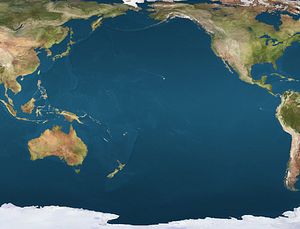Despite enjoying a long Pacific coastline, the Latin American navies have historically projected power into the Pacific only with great reluctance. While the Brazilian Navy actively participated in both World Wars on the Allied side, its operations were largely limited to the Atlantic.
The naval commitments of the eastern Pacific states vary considerably. The Mexican Navy, for example, punches dramatically under its weight. Mexican GDP is higher, PPP adjusted, than Malaysia, South Korea, or Thailand, but Mexican defense spending is remarkably low. The Mexican Navy has only two World War II vintage destroyers and six Cold War vintage frigates, with no submarines and minimal naval air.
The situation gets better in South America; Ecuador operates two frigates and two submarines, Colombia four of each, and Peru six of each. Most of the submarines are Type 209 or similar diesel-electrics, the frigates 1970s-era European transfers.
The Chilean Navy has long held pride of place among the Latin American navies on the Pacific coast. As early as the late 19th century, Chile determined to embark on competition with Brazil and Argentina for naval supremacy in South America. Shortly prior to World War I, Chile contracted for the construction of a pair of modern battleships in the United Kingdom. At the outbreak of war both were seized by the Royal Navy, becoming the super-dreadnought HMS Canada and (eventually) the aircraft carrier HMS Eagle. HMS Canada, after serving at Jutland, was eventually returned to Chile to become Almirante Latorre.
The United States Navy gave some thought to attempting to lease Almirante Latorre in the wake of the Pearl Harbor attack. However, Chile was reluctant to allow the ship to participate in another world war under another flag, and the Americans did not pursue the issue. Today, the Chilean Navy is one of the largest and most modern fleets in the region, boasting four modern submarines and eight relatively modern frigates. Chile also has an array of Pacific Ocean island bases.
However, none of the Pacific navies (or any Latin American navy) possess a modern amphibious assault ship, or any vessel capable of projecting naval aviation. It’s not hard to come up with an explanation for why Mexico in particular and Latin American more generally have shirked naval spending; the presence of the United States Navy serves to manage most critical maritime threats. The Latin American countries also tend to have fewer of the littoral territorial disputes that characterize modern East Asian international relations.
Nevertheless, Latin American navies face the same problems as many other global navies: protection of legitimate commerce, management of drug and human trafficking, and even occasional piracy. Were U.S. naval hegemony to wane, the Latin American navies might have to take up a greater part of the maritime burden. Some signs suggest that the Pacific coast navies have become increasingly integrated into the Pacific maritime system. Chile, Colombia, Peru, and Mexico participated in the 2012 RIMPAC exercises, and each of the four is expected to participate again in 2014.
Nevertheless, there is relatively little reason to think that the South American navies, even along the continent’s Pacific coast, will seek to play a larger role in Asia-Pacific security affairs in the near future. Although several Latin American countries enjoy growing trade with China and other East Asian states, they continue to rely primarily on the USN and other regional navies for the maintenance of maritime affairs. In the future, it will be interesting to see whether any of the Latin American fleets develop closer relationships with the PLAN, perhaps to the extent of diversifying supply of ships, submarines, and aircraft.

































